C语言函数大全
本篇介绍C语言中f开头的函数(下)
1. floor,floorf,floorl
1.1 函数说明
double floor (double x);
获取小于或等于 x 的最大整数(double)。
float floorf (float x);
获取小于或等于 x 的最大整数(float)。
long double floorl (long double x)
获取小于或等于 x 的最大整数(long double)。
1.2 演示示例
#include<stdio.h>
#include<math.h>
int main()
{
double x = 10.24;
printf("floor(%.2lf) = %.2lf\n", x, floor(x));
float xf = 5.63;
printf("floorf(%.2f) = %.2f\n", xf, floorf(xf));
long double xL = 2.89;
printf("floorl(%.2Lf) = %.2Lf\n", xL, floorl(xL));
return 0;
}
1.3 运行结果
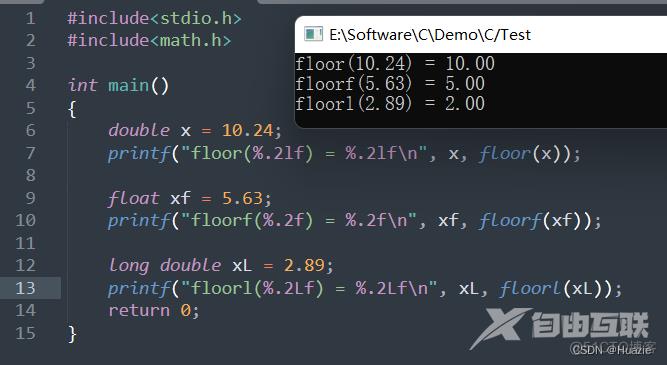
2. _flushall
2.1 函数说明
int _flushall(void);
清除所有缓冲区,返回打开的流(输入和输出)的数量
2.2 演示示例
#include <stdio.h>
int main()
{
FILE *stream = fopen("STU.FIL", "w");
// 清除所有缓冲区
// 返回打开的流(输入和输出)的数量
printf("%d streams were flushed.\n", _flushall());
fclose(stream);
return 0;
}
2.3 运行结果
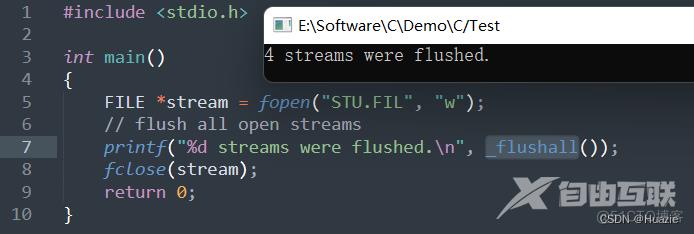
3. fma,fmaf,fmal
3.1 函数说明
double fma (double x, double y, double z);
计算x*y+z的值,并将结果四舍五入(double)。
float fmaf (float x, float y, float z );
计算x*y+z的值,并将结果四舍五入(float )。
long double fmal (long double x, long double y, long double z);
计算x*y+z的值,并将结果四舍五入(double)。
3.2 演示示例
#include <stdio.h>
#include <math.h>
int main() {
double x = 2.0, y = 3.0, z = 4.0;
float xf = 2.0, yf = 3.0, zf = 4.0;
long double xL = 2.0, yL = 3.0, zL = 4.0;
printf("fma(%lf, %lf, %lf) = %lf\n", x, y, z, fma(x, y, z));
printf("fmaf(%f, %f, %f) = %f\n", xf, yf, zf, fmaf(xf, yf, zf));
printf("fmal(%Lf, %Lf, %Lf) = %Lf\n", xL, yL, zL, fmal(xL, yL, zL));
return 0;
}
3.3 运行结果
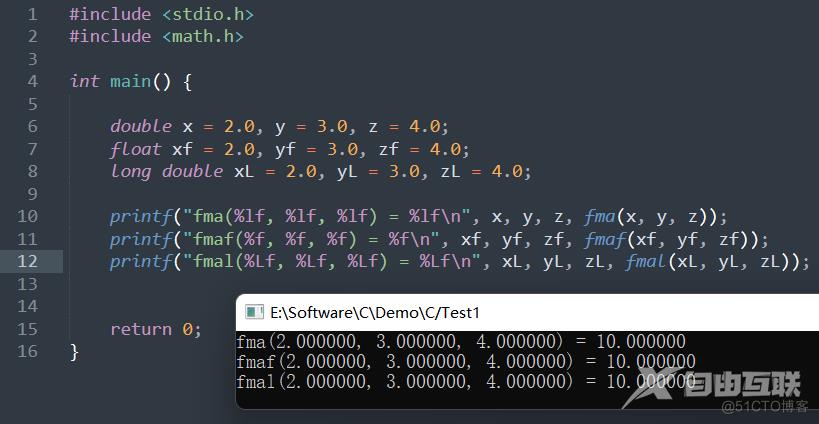
4. fmax,fmaxf,fmaxl
4.1 函数说明
double fmax (double x, double y);
获取 x 和 y 中的最大值(double)
float fmaxf (float x, float y);
获取 x 和 y 中的最大值(float)
long double fmaxl (long double x, long double y);
获取 x 和 y 中的最大值(long double)
4.2 演示示例
#include<stdio.h>
#include<math.h>
int main()
{
double x = 10.24, y = 5.63;
printf("fmax(%.2lf, %.2lf) = %.2lf\n", x, y, fmax(x, y));
float xf = 5.63, yf = 2.89;
printf("fmaxf(%.2f, %.2f) = %.2f\n", xf, yf, fmaxf(xf, yf));
long double xL = 2.89, yL = 4.56;
printf("fmaxl(%.2Lf, %.2Lf) = %.2Lf\n", xL, yL, fmaxl(xL, yL));
return 0;
}
4.3 运行结果
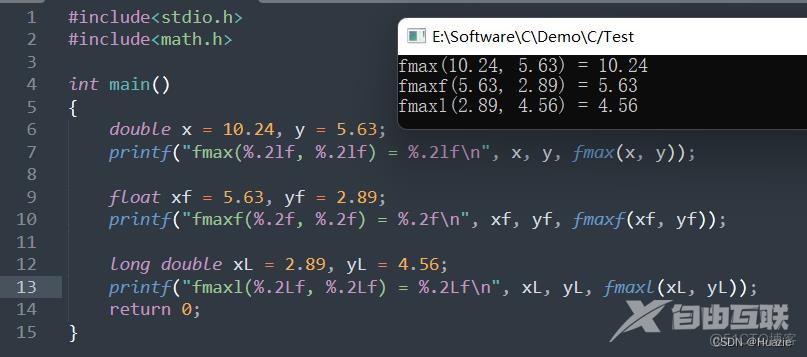
5. fmin,fminf,fminl
5.1 函数说明
double fmin (double x, double y);
获取 x 和 y 中的最小值(double)
float fminf (float x, float y);
获取 x 和 y 中的最小值(float)
long double fminl (long double x, long double y);
获取 x 和 y 中的最小值(long double)
5.2 演示示例
#include<stdio.h>
#include<math.h>
int main()
{
double x = 10.24, y = 5.63;
printf("fmin(%.2lf, %.2lf) = %.2lf\n", x, y, fmin(x, y));
float xf = 5.63, yf = 2.89;
printf("fminf(%.2f, %.2f) = %.2f\n", xf, yf, fminf(xf, yf));
long double xL = 2.89, yL = 4.56;
printf("fminl(%.2Lf, %.2Lf) = %.2Lf\n", xL, yL, fminl(xL, yL));
return 0;
}
5.3 运行结果

6. fmod,fmodf,fmodl
6.1 函数说明
double fmod (double x, double y);
计算 x 除以 y 的余数(double)。
float fmodf (float x, float y);
计算 x 除以 y 的余数(float)。
long double fmodl (long double x, long double y);
计算 x 除以 y 的余数(long double)。
6.2 演示示例
#include<stdio.h>
#include<math.h>
int main()
{
double x = 10.24, y = 5.63;
printf("fmod(%.2lf, %.2lf) = %.20lf\n", x, y, fmod(x, y));
float xf = 5.63, yf = 2.89;
printf("fmodf(%.2f, %.2f) = %.20f\n", xf, yf, fmodf(xf, yf));
long double xL = 2.89, yL = 4.56;
printf("fmodl(%.2Lf, %.2Lf) = %.20Lf\n", xL, yL, fmodl(xL, yL));
return 0;
}
6.3 运行结果
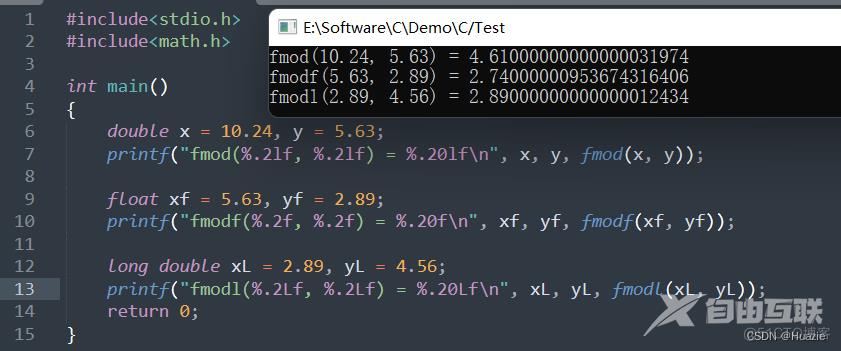
7. fopen
7.1 函数说明
FILE *fopen(const char *filename, const char *mode);
使用给定的模式mode打开filename所指向的文件。
参数: filename: 要打开的文件全路径名 mode: 文件访问模式
返回值: 如果文件顺利打开后,指向该流的文件指针就会被返回;否则文件打开失败则返回 NULL,并把错误代码存在 error 中。
文件访问模式
"r"
以只读模式打开文件,该文件必须存在。
"w"
以只写模式打开文件。若文件不存在则创建该文件。若文件存在则其现有内容将被清除。
"a"
以追加模式打开只写文件。若文件不存在则创建该文件;如果文件存在,则新写入的数据会被加到文件尾后。
"r+"
以读写模式打开文件,该文件必须存在。
"w+"
以读写模式打开文件。若文件不存在则创建该文件。若文件存在则其内容将被清除。
"a+"
以追加模式打开可读写文件。若文件不存在则创建该文件;如果文件存在,则新写入的数据会被加到文件尾后。
"rb"
以只读模式打开一个二进制文件。
"wb"
以只写模式打开或新建一个二进制文件。
"ab"
以追加模式打开一个二进制文件,并在文件末尾写入数据。
"rb+"
以读写模式打开一个二进制文件,该文件必须存在。
"wb+"
以读写模式打开或创建一个二进制文件。
"ab+"
以追加模式打开一个二进制文件,以便在文件末尾写入数据。该文件也是可读的。
"rt"
以只读模式打开一个文本文件。
"wt"
以只读模式打开或创建文本文件。
"at"
以追加模式打开一个文本文件,并在文件末尾写入数据。
"rt+"
以读写模式打开一个文本文件。
"wt+"
以读写模式打开或创建文本文件。
"at+"
以追加模式打开文本文件,以便在文件末尾写入数据。该文件也是可读的。
7.2 演示示例
#include <string.h>
#include <stdio.h>
int main(void)
{
FILE *fp;
char buf[30] = "Hello, Huazie 123456789";
fp = fopen("STU.FIL", "w");
printf("temp.txt is created and opened\n");
fwrite(&buf, strlen(buf), 1, fp);
printf("temp.txt is writed\n");
fclose(fp);
printf("temp.txt is closed");
return 0;
}
7.3 运行结果


8. fprintf
8.1 函数说明
int fprintf(FILE *stream, char *format[, argument,...]);
格式化输出到一个流文件中
8.2 演示示例
#include <stdio.h>
int main()
{
FILE *stream;
stream = fopen("temp.txt", "w");
fprintf(stream, "%s:%d\n", "Hello Huazie", 456);
fclose(stream);
return 0;
}
8.3 运行结果

9. fputc
9.1 函数说明
int fputc(int ch, FILE *stream);
将字符【ch为字符的ascii码】写到文件指针stream所指向的文件的当前写指针的位置
注意: 在正常调用情况下,函数返回写入文件的字符的 ASCII 码值,出错时,返回 EOF(-1)。当正确写入一个字符或一个字节的数据后,文件内部写指针会自动后移一个字节的位置。EOF是在头文件 stdio.h中定义的宏。
9.2 演示示例
#include <stdio.h>
int main(void)
{
char msg[] = "Hello Huazie";
int i = 0;
while (msg[i])
{
fputc(msg[i], stdout);
i++;
}
return 0;
}
9.3 运行结果
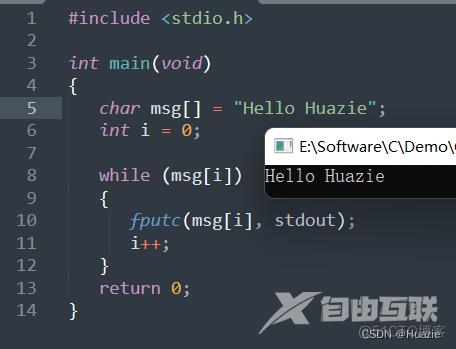
10. fputchar
10.1 函数说明
int fputchar(char ch);
送一个字符到标准输出流(stdout)中,出错则返回EOF
10.2 演示示例
#include <stdio.h>
int main(void)
{
char msg[] = "This is a test";
int i = 0;
while (msg[i])
{
fputchar(msg[i]);
i++;
}
return 0;
}
10.3 运行结果
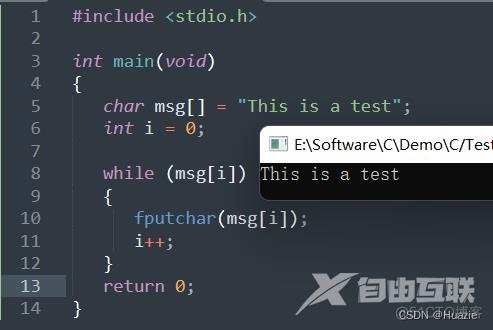
11. fputs
11.1 函数说明
int fputs(const char *str, FILE *stream);
把字符串写入到指定的流( stream) 中,但不包括空字符。
注意: fputs 函数如果成功则返回 0,如果发生错误则返回 EOF(-1)
11.2 演示示例
#include <stdio.h>
int main()
{
int result = fputs("Hello Huazie\n1234", stdout);
printf("\nresult = %d", result);
return 0;
}
11.3 运行结果
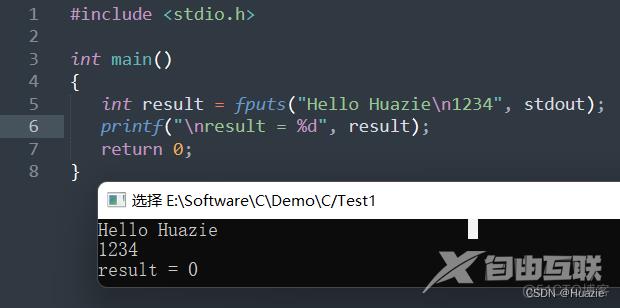
12. fread
12.1 函数说明
int fread(void *buffer, int size, int count, FILE *stream);
从给定输入流stream读取最多count个对象到数组buffer中
参数: buffer : 指向要读取的数组中首个对象的指针 size : 每个对象的大小(单位是字节) count : 要读取的对象个数 stream : 指定输入流
返回值: 返回成功读取的对象个数,若出现错误或到达文件末尾,则可能小于count。 若 size 或 count 为零,则 fread 返回零且不进行其他动作。 fread 不区分文件尾和错误,因此调用者必须用 feof 和 ferror 才能判断发生了什么。
注意: 如果读取成功,流的文件位置指示器前进读取的字节数;否则出现错误,则流的文件位置指示器的位置不确定。同样若没有完整地读入最后一个元素,则其值也不确定。
12.2 演示示例
#include <string.h>
#include <stdio.h>
int main(void)
{
FILE *stream;
char msg[20] = "Hello, Huazie";
char buf[20];
// 以读写模式打开文件。若文件不存在则创建该文件。若文件存在则其内容将被清除。
if ((stream = fopen("temp.txt", "w+")) == NULL)
{
fprintf(stderr, "Cannot open output file.\n");
return 1;
}
// 向文件流中写入数据
fwrite(msg, strlen(msg)+1, 1, stream);
// 重定位流上的文件指针到文件开头
fseek(stream, SEEK_SET, 0);
// 从文件流中读取数据
fread(buf, strlen(msg)+1, 1, stream);
printf("%s\n", buf);
fclose(stream);
return 0;
}
12.3 运行结果
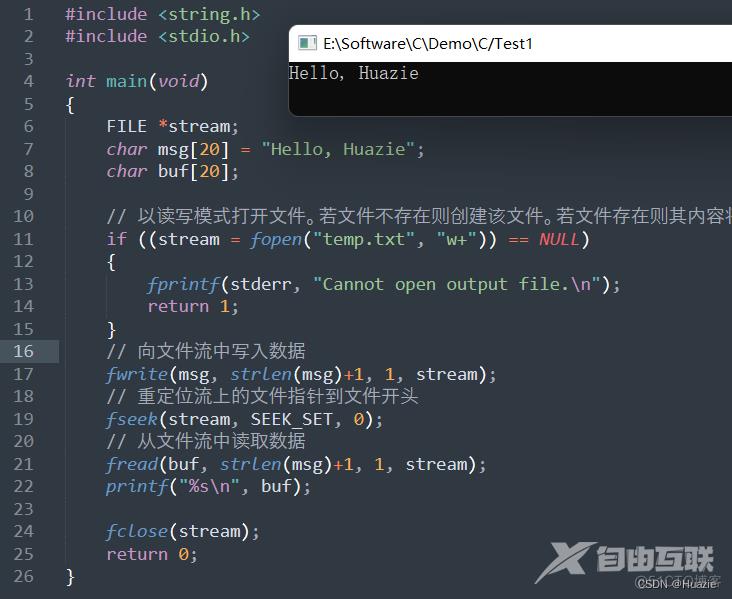
13. free
13.1 函数说明
void free(void *ptr);
释放ptr指向的存储空间
注意: 被释放的空间通常被送入可用存储区池,以后可以在调用 malloc、realloc 以及 calloc 函数来再分配。
13.2 演示示例
#include <stdio.h>
#include <string.h>
#include <malloc.h>
int main()
{
char *str;
str = (char *) malloc(7);
strcpy(str, "huazie");
printf("string = %-10s, Address = %u, len = %d\n", str, str, strlen(str));
str = (char *) realloc(str,25); //重新分配内存
strcat(str, ".com");
printf("string = %-10s, Address = %u, len = %d\n", str, str, strlen(str));
free(str);// 释放已分配的内存空间
//内存空间释放后,该空间上的值未知
printf("string = %-10s, Address = %u, len = %d\n", str, str, strlen(str));
return 0;
}
13.3 运行结果
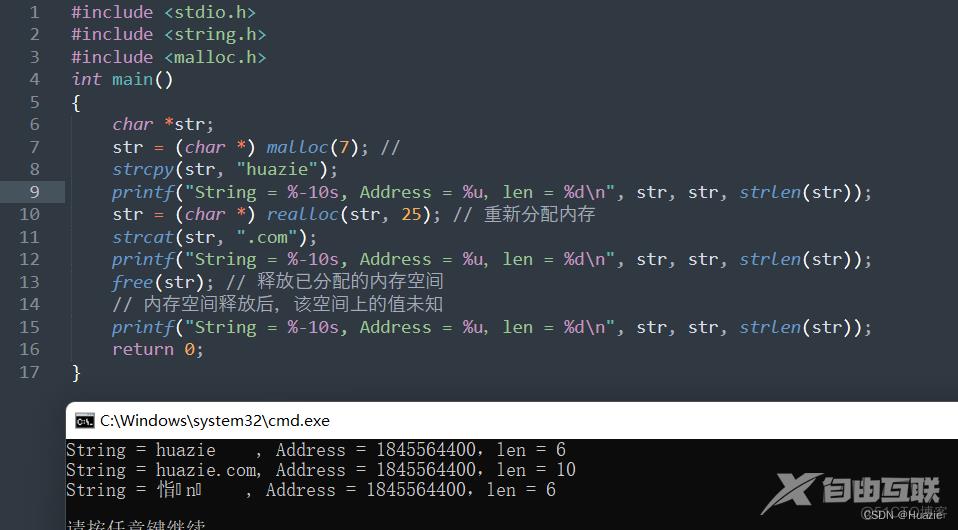
14. freopen
14.1 函数说明
FILE * freopen(const char *filename, const char *mode, FILE *stream);
以指定模式重新指定到另一个文件
参数: filename: 需要重定向到的文件名或文件路径。 mode: 代表文件访问权限的字符串。 参见 27 fopen stream: 需要被重定向的文件流。
14.2 演示示例
#include<stdio.h>
int main()
{
if(freopen("temp.txt", "w", stdout) == NULL)
fprintf(stderr,"error redirecting stdout\n");
printf("Hello, %s", "Huazie");
fclose(stdout);
return 0;
}
14.3 运行结果

15. frexp,frexpf,frexpl
15.1 函数说明
double frexp (double x, int * exp);
将x 分解为有效位 和 2 的整数指数。(double)。
float frexpf (float x, int * exp);
将x 分解为有效位 和 2 的整数指数。(float)。
long double frexpl (long double x, int * exp);
将x 分解为有效位 和 2 的整数指数。(long double)。
注意: 有效位的绝对值范围为 0.5(包括) 到 1(不包括)。x = 有效位 * $2^{exp}$
15.2 演示示例
#include<stdio.h>
#include<math.h>
int main()
{
int exp;
double x = 10.24;
printf("frexp(%.2lf, exp = %d) = %.20lf\n", x, exp, frexp(x, &exp));
float xf = 5.63;
printf("frexpf(%.2f, exp = %d) = %.20f\n", xf, exp, frexpf(xf, &exp));
long double xL = 2.89;
printf("frexpl(%.2Lf, exp = %d) = %.20Lf\n", xL, exp, frexpl(xL, &exp));
return 0;
}
15.3 运行结果
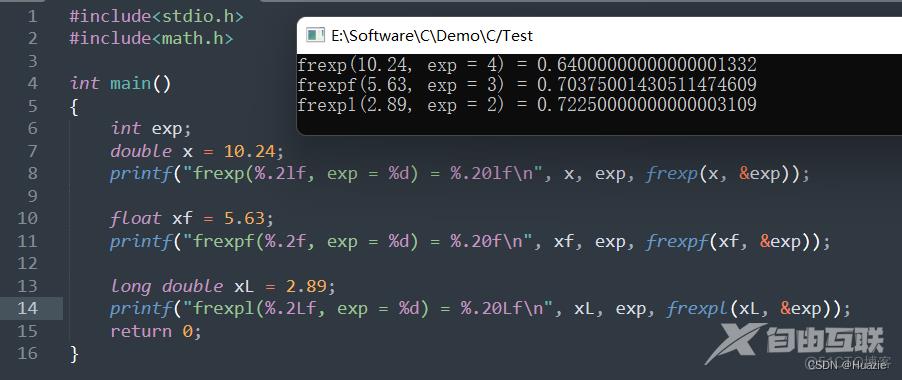
16. fscanf
16.1 函数说明
int fscanf(FILE *stream, char *format[,argument...]);
从一个流中执行格式化输入
注意: fscanf 遇到空格和换行时结束。它与 fgets 有区别,fgets 遇到空格不结束。
16.2 演示示例
#include <stdlib.h>
#include <stdio.h>
int main(void)
{
int i;
printf("Input an integer: ");
if (fscanf(stdin, "%d", &i))
printf("The integer is: %d\n", i);
else
{
fprintf(stderr, "Error reading an integer from stdin.\n");
exit(1);
}
return 0;
}
16.3 运行结果
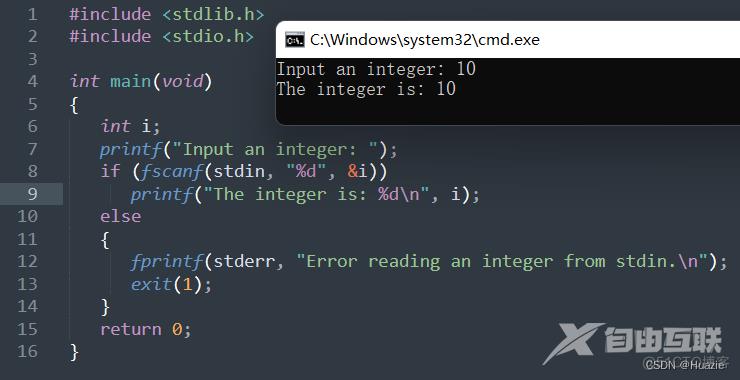
17. fseek
17.1 函数说明
int fseek(FILE *stream, long offset, int fromwhere);
重定位流上的文件指针位置
注意: 如果执行成功,stream 将指向以 fromwhere【偏移起始位置:文件头 0(SEEK_SET),当前位置 1(SEEK_CUR),文件尾2(SEEK_END) 】为基准,偏移 offset(指针偏移量)个字节的位置。如果执行失败(比如 offset 超过文件自身大小),则不改变 stream 指向的位置。
17.2 演示示例
#include <stdio.h>
long filesize(FILE *stream);
int main(void)
{
FILE *stream = fopen("temp.txt", "w+");
fprintf(stream, "This is a test");
printf("The size of temp.txt is %ld bytes\n", filesize(stream));
fclose(stream);
return 0;
}
long filesize(FILE *stream)
{
long curpos, length;
// 文件指针当前位置相对于文件首的偏移字节数
curpos = ftell(stream);
// 重定向文件指针到文件尾,偏移量 0
fseek(stream, 0L, SEEK_END);
length = ftell(stream);
return length;
}
17.3 运行结果
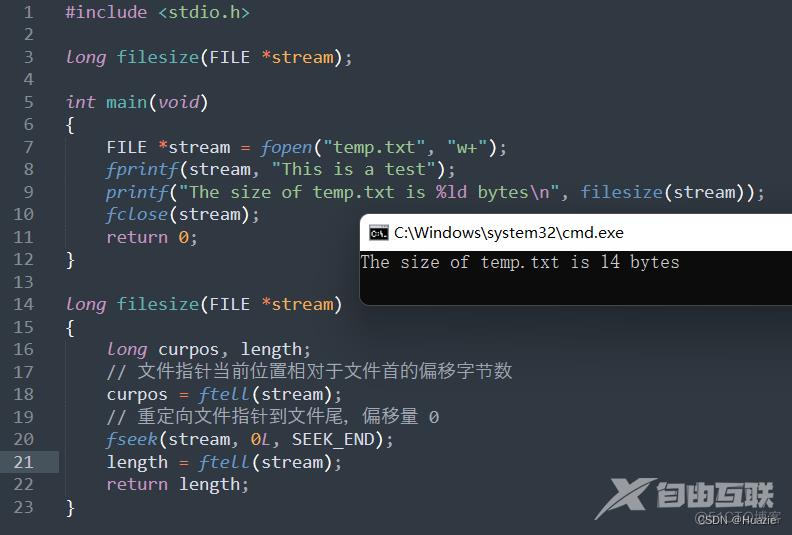

18. fsetpos
18.1 函数说明
int fsetpos(FILE *stream, const fpos_t *pos);
将文件指针定位在pos指定的位置上。如果成功返回0,否则返回非0。
18.2 演示示例
#include <stdlib.h>
#include <stdio.h>
void showpos(FILE *stream);
int main(void)
{
FILE *stream;
fpos_t filepos;
stream = fopen("STU.FIL", "w+");
// 获取当前文件指针的位置
fgetpos(stream, &filepos);
fprintf(stream, "This is a test");
// 展示当前文件指针的位置
showpos(stream);
/* set a new file position, display it */
if (fsetpos(stream, &filepos) == 0)
showpos(stream);
else
{
fprintf(stderr, "Error setting file pointer.\n");
exit(1);
}
fclose(stream);
return 0;
}
void showpos(FILE *stream)
{
fpos_t pos;
// 展示当前文件指针的位置
fgetpos(stream, &pos);
printf("File position: %ld\n", pos);
}
18.3 运行结果

19. fstat
19.1 函数说明
int fstat(int handle,struct stat *buf);
由文件描述符获取文件状态
19.2 演示示例
#include <sys\stat.h>
#include <stdio.h>
#include <time.h>
int main()
{
struct stat statbuf;
FILE *stream;
if ((stream = fopen("STU.FIL", "w+")) == NULL)
{
fprintf(stderr, "Cannot open output file.\n");
exit(1);
}
fprintf(stream, "This is a test");
fflush(stream);
// get information about the file
fstat(fileno(stream), &statbuf);
fclose(stream);
if (statbuf.st_mode & S_IFCHR)
printf("Handle refers to a device.\n");
if (statbuf.st_mode & S_IFREG)
printf("Handle refers to an ordinary file.\n");
if (statbuf.st_mode & S_IREAD)
printf("User has read permission on file.\n");
if (statbuf.st_mode & S_IWRITE)
printf("User has write permission on file.\n");
// 不知道为啥,我这里文件的驱动号是空
printf("Drive letter of file: %c\n", statbuf.st_dev);
printf("Size of file in bytes: %ld\n", statbuf.st_size);
printf("Time file last opened: %s\n", ctime(&statbuf.st_ctime));
return 0;
}
19.3 运行结果
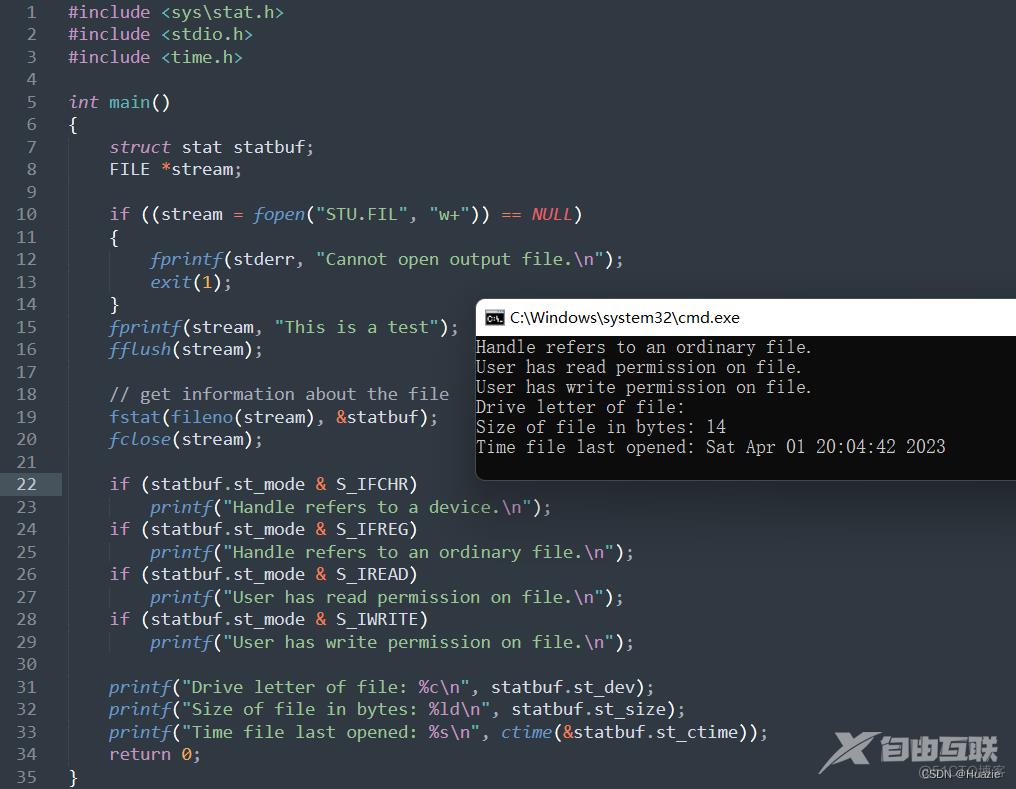
20. ftell
20.1 函数说明
long ftell(FILE *stream);
获取文件指针当前位置相对于文件首的偏移字节数
20.2 演示示例
#include <stdio.h>
int main(void)
{
FILE *stream = fopen("temp.txt", "w+");
fprintf(stream, "This is a test");
printf("The file pointer is at byte %ld\n", ftell(stream));
fclose(stream);
return 0;
}
20.3 运行结果

21. fwrite
21.1 函数说明
int fwrite(const void *ptr, int size, int nitems, FILE *stream);
把ptr所指向的数组中的数据写入到给定流stream中
参数: ptr: 指向要被写入的元素数组的指针。 size: 要被写入的每个元素的大小,以字节为单位。 nitems: 元素的个数,每个元素的大小为 size 字节。 stream: 指向 FILE 对象的指针,该 FILE 对象指定了一个输出流。
注意: 如果写入成功,fwrite 返回一个 size_t 对象,表示元素的总数,该对象是一个整型数据类型。如果该数字与 nitems 参数不同,则会显示一个错误。
21.2 演示示例
#include <stdio.h>
struct mystruct
{
int i;
char ch;
};
int main(void)
{
FILE *stream;
struct mystruct s;
// 以只写模式打开或新建一个二进制文件。
if ((stream = fopen("test.txt", "wb")) == NULL)
{
fprintf(stderr, "Cannot open output file.\n");
return 1;
}
s.i = 0;
s.ch = 'A';
fwrite(&s, sizeof(s), 1, stream);
fclose(stream);
// 以只读模式打开或新建一个二进制文件。
if ((stream = fopen("test.txt", "rb")) == NULL)
{
fprintf(stderr, "Cannot open output file.\n");
return 1;
}
struct mystruct s1;
fread(&s1, sizeof(s1), 1, stream);
printf("%d %c", s1.i, s1.ch);
fclose(stream);
return 0;
}
21.3 运行结果
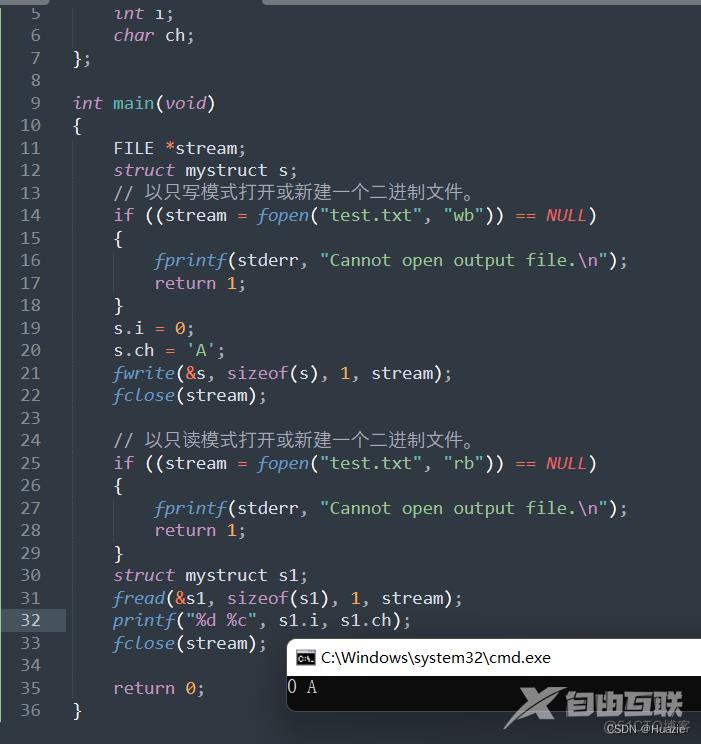
参考
- [API Reference Document]
- [IO-标准C库]
- [fread]
- [freopen]
- [fseek]
- [fwrite]
